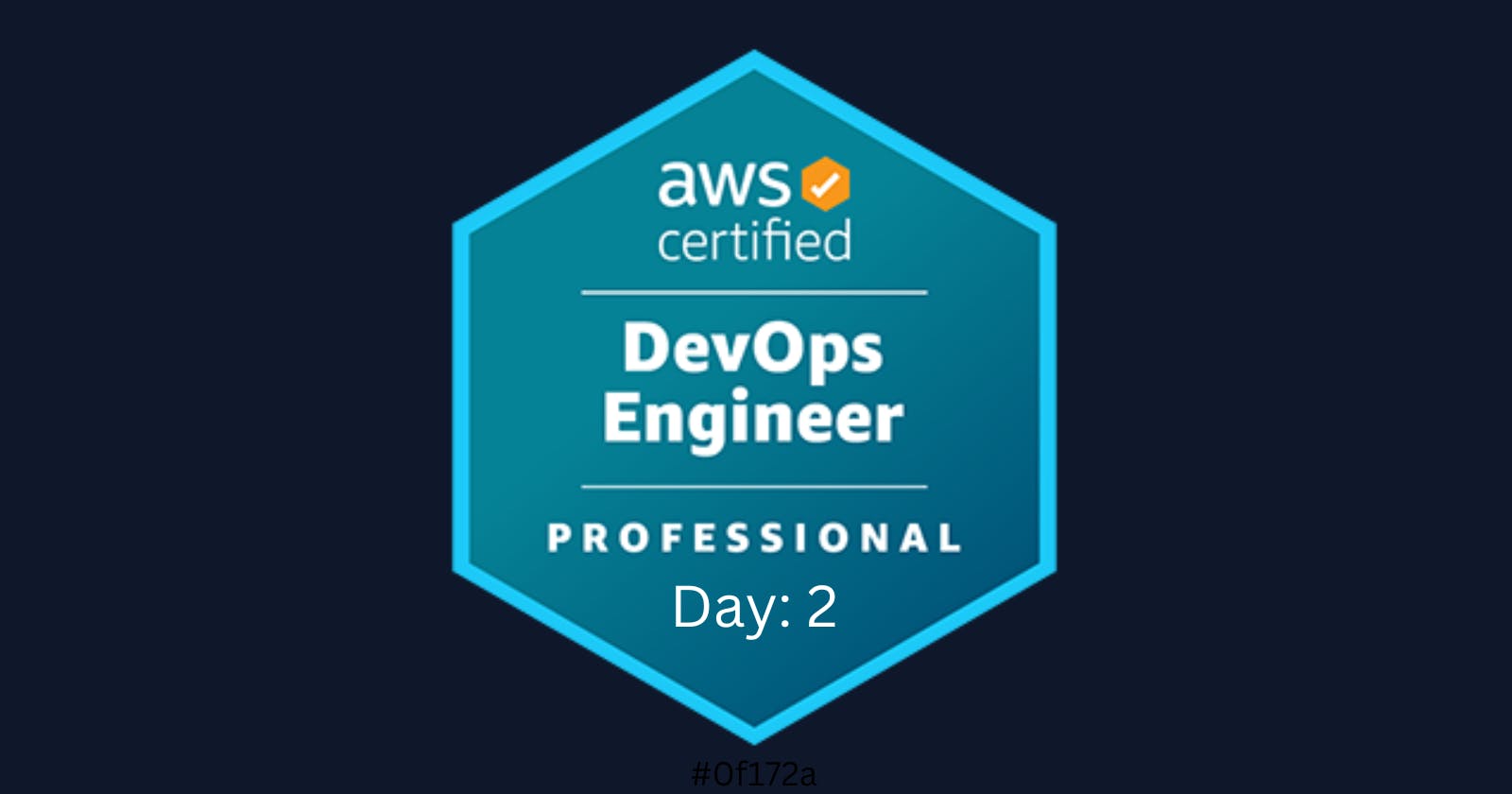Hey tech enthusiasts! Welcome back to my AWS DevOps certification journey. Day 2 has been a whirlwind of learning and exploration, and I can't wait to share my insights and hands-on experiences with you.
📚 Course Progress: Continuing with the fantastic Udemy course by Stéphane Maarek, today's focus was on AWS CodeBuild, AWS CodeDeploy, AWS CodeArtifact, AWS CodeGuru, EC2 Image Builder, and AWS Amplify.
💻 AWS CodeBuild:
Introduction: Unpacked the fundamentals of AWS CodeBuild, a fully managed continuous integration service.
Hands-on Basics: Got hands-on with basic CodeBuild tasks, understanding how it seamlessly compiles and tests code.
🛠️ Advanced CodeBuild Concepts:
Build Specifications: Delved into advanced concepts, particularly build specifications, to fine-tune and customize the build process.
Build Environments: Explored different build environments, optimizing for various project requirements.
AWS CodeBuild is a fully managed continuous integration service that compiles source code, runs tests, and produces software packages that are ready to deploy. It eliminates the need to provision, manage, and scale your own build servers. CodeBuild scales continuously and processes multiple builds concurrently, so your builds are not left waiting in a queue. You can use CodeBuild to build applications for any language, including .NET, Java, Python, Ruby, Go, and more. You can also use CodeBuild to build Docker images. CodeBuild integrates with other AWS services such as AWS CodeCommit, AWS CodePipeline, and AWS CodeDeploy, making it easy to set up a complete continuous delivery and deployment pipeline.
🚀 Overview of AWS CodeDeploy:
Deployment Automation: Explored AWS CodeDeploy, focusing on its role in automating application deployments.
EC2 Deep Dive: Dived deep into CodeDeploy with a focus on EC2 instances, understanding deployment strategies and best practices.
ECS Deep Dive: Extended the knowledge to ECS, exploring seamless deployments in containerized environments.
Lambda Deep Dive: Delved into serverless deployments with AWS Lambda using CodeDeploy.
AWS CodeDeploy is a fully managed deployment service that automates software deployments to a variety of compute services such as Amazon EC2, AWS Fargate, AWS Lambda, and your on-premises servers. CodeDeploy makes it easier to rapidly release new features, helps you avoid downtime during application deployment, and handles the complexity of updating your applications. You can use CodeDeploy to deploy a nearly unlimited variety of application content, such as code, web and configuration files, executables, packages, scripts, multimedia files, and so on. CodeDeploy can deploy application content stored in Amazon S3 buckets, GitHub repositories, or Bitbucket repositories. CodeDeploy also provides a set of deployment strategies, such as rolling deployments, blue/green deployments, and canary deployments, to help you minimize downtime and reduce the risk of failed deployments.
🚀 EC2 Deep Dive on CodeDeploy
Amazon Elastic Compute Cloud (Amazon EC2) is a web service that provides resizable compute capacity in the cloud. It is designed to make web-scale cloud computing easier for developers. Amazon EC2’s simple web service interface allows you to obtain and configure capacity with minimal friction. It provides you with complete control of your computing resources and lets you run on Amazon’s proven computing environment. AWS CodeDeploy can deploy your applications to Amazon EC2 instances running Windows or Linux operating systems.
🚀 ECS Deep Dive on CodeDeploy
Amazon Elastic Container Service (Amazon ECS) is a fully managed container orchestration service that makes it easy to run, stop, and manage Docker containers on a cluster. You can use Amazon ECS to deploy a scalable and highly available containerized application. AWS CodeDeploy can deploy your applications to Amazon ECS clusters.
🚀 Lambda Deep Dive on CodeDeploy
AWS Lambda is a serverless compute service that lets you run code without provisioning or managing servers. You can use AWS Lambda to run your code in response to events, such as changes to data in an Amazon S3 bucket, or to run your code in response to HTTP requests using Amazon API Gateway. AWS CodeDeploy can deploy your Lambda functions.
🔍 CodeDeploy Rollbacks and Troubleshooting:
Rollback Strategies: Explored strategies for rolling back deployments, ensuring system stability in case of issues.
Troubleshooting Techniques: Learned effective troubleshooting techniques for CodeDeploy, ensuring smooth deployments.
AWS CodeDeploy provides a set of rollback and troubleshooting features to help you quickly recover from failed deployments. CodeDeploy can automatically roll back a deployment if errors occur during the deployment process. CodeDeploy also provides detailed deployment logs, which you can use to troubleshoot issues that arise during deployment.
📦 Overview of AWS CodeArtifact:
AWS CodeArtifact is a fully managed artifact repository service that makes it easy to store, publish, and share software packages. You can use CodeArtifact to store and manage artifacts such as Maven and Python packages, Docker images, and npm packages. CodeArtifact integrates with other AWS services such as AWS CodeBuild, AWS CodePipeline, and AWS CodeDeploy, making it easy to set up a complete continuous delivery and deployment pipeline.
🧠 Overview of AWS CodeGuru:
- Code Optimization: Gained insights into AWS CodeGuru, focusing on its capabilities in providing automated code reviews and performance recommendations.
AWS CodeGuru is a machine learning-based service that provides automated code reviews and application performance recommendations. CodeGuru uses machine learning algorithms to identify issues such as resource leaks, concurrency bugs, and incorrect handling of sensitive data. CodeGuru provides actionable recommendations to help you improve your code quality and application performance.
💻 EC2 Image Builder:
- Automated Image Creation: Explored EC2 Image Builder, automating the creation of Amazon Machine Images (AMIs) with pre-configured software.
EC2 Image Builder is a fully managed service that makes it easy to build and maintain secure and up-to-date Amazon Machine Images (AMIs). You can use EC2 Image Builder to automate the creation, management, and deployment of AMIs for your applications. EC2 Image Builder integrates with other AWS services such as AWS CodeCommit, AWS CodePipeline, and AWS CodeDeploy, making it easy to set up a complete continuous delivery and deployment pipeline.
🌐 Overview of AWS Amplify:
- Full-Stack App Development: Wrapped up the day with an overview of AWS Amplify, a powerful tool for full-stack app development with simplified workflows.
AWS Amplify is a development platform that makes it easy to develop and deploy cloud-powered mobile and web applications. With Amplify, you can build full-stack web and mobile apps in hours with a few lines of code. You can configure a backend, connect to data sources, add features like authentication, storage, and hosting, and scale to millions of users with AWS services and pricing.
Amplify provides frontend libraries, UI components, backend building, and frontend hosting for building full-stack cloud apps 1. It offers a declarative interface across different categories of operations to make common tasks easier to add into your application 2. Amplify provides a set of deployment strategies, such as rolling deployments, blue/green deployments, and canary deployments, to help you minimize downtime and reduce the risk of failed deployments.
Amplify also provides a set of features to help you build and deploy your applications quickly and easily. For example, you can use Amplify to build cloud-connected UIs with dozens of pre-built, themeable, and responsive cloud-connected React components 1. You can also use Amplify to build secure, real-time GraphQL APIs backed by AWS databases quickly and easily 1. Amplify provides a set of features to enable secure authentication flows with email/social sign-up and multi-factor auth 1. You can also store user-created content and application data in Amazon S3 buckets and enable file uploading and display with pre-built components.
In summary, AWS Amplify is a powerful development platform that provides a wide range of features and tools to help you build and deploy cloud-powered mobile and web applications quickly and easily. With Amplify, you can build full-stack cloud apps in hours with a few lines of code, and scale to millions of users with AWS services and pricing.
This Day 2 journey has been packed with technical depth and hands-on exploration. Stay tuned for more updates as I progress in this exciting AWS DevOps certification adventure! 🚀💻🌐

